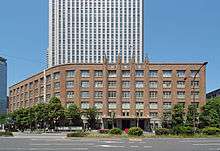Agency for Cultural Affairs
|
文化庁 Bunka-chō | |
 Office building | |
| Agency overview | |
|---|---|
| Formed | June 15, 1968 |
| Preceding agencies |
|
| Jurisdiction |
|
| Headquarters |
3-2-2 Kasumigaseki, Chiyoda-ku, Tokyo 100-8959, Japan 35°40′17″N 139°44′58″E / 35.67139°N 139.74944°ECoordinates: 35°40′17″N 139°44′58″E / 35.67139°N 139.74944°E |
| Annual budget | ¥104 billion (2016) |
| Minister responsible |
|
| Deputy Minister responsible |
|
| Parent department | Ministry of Education, Culture, Sports, Science and Technology |
| Child agency | |
| Website |
www |

The Agency for Cultural Affairs (文化庁 bunkachō) is a special body of the Japanese Ministry of Education, Culture, Sports, Science and Technology (MEXT). It was set up in 1968 to promote Japanese arts and culture. As of April 2016, it is led by the Commissioner for Cultural Affairs, Ryohei Miyata.
The agency's budget for FY 2015 rose to ¥103.8 billion.[1] The agency's Cultural Affairs Division disseminated information about the arts within Japan and internationally, and the Cultural Properties Protection Division protected the nation's cultural heritage. The Cultural Affairs Division is concerned with such areas as art and culture promotion, arts copyrights, and improvements in the national language. It also supports both national and local arts and cultural festivals, and it funds traveling cultural events in music, theater, dance, art exhibitions, and film-making. Special prizes are offered to encourage young artists and established practitioners, and some grants are given each year to enable them to train abroad. The agency funds national museums of modern art in Kyoto and Tokyo and The National Museum of Western Art in Tokyo, which exhibit both Japanese and international shows. The agency also supports the Japan Art Academy, which honors eminent persons of arts and letters, appointing them to membership and offering ¥3.5 million in prize money. Awards are made in the presence of the Emperor, who personally bestows the highest accolade, the Order of Culture. In 1989, for the first time two women — a writer and a costume designer — were nominated for the Order of Cultural Merit, another official honor carrying the same stipend.
The Cultural Properties Protection Division originally was established to oversee restorations after World War II. As of April 2015, it was responsible for 1,745 historic sites, including the ancient capitals of Asuka, Heijokyo, and Fujiwara, 393 scenic places, and 1,013 national monuments, and for such indigenous fauna as ibis and storks. In addition, about 13,500 items had the lesser designation of Important Cultural Properties, with fine arts and crafts accounting for the largest share, with over 10,000 so designated.[2]
The government protects buried properties, of which some 300,000 had been identified. During the 1980s, many important prehistoric and historic sites were investigated by the archaeological institutes that the agency funded, resulting in about 2,000 excavations in 1989. The wealth of material unearthed shed new light on the controversial period of the formation of the Japanese state.
A 1975 amendment to the Cultural Properties Protection Act of 1897 enabled the Agency for Cultural Affairs to designate traditional areas and buildings in urban centers for preservation. From time to time, various endangered traditional artistic skills are added to the agency's preservation roster, such as the 1989 inclusion of a kind of ancient doll making.
One of the most important roles of the Cultural Properties Protection Division is to preserve the traditional arts and crafts and performing arts through their living exemplars. Individual artists and groups, such as a dance troupe or a pottery village, are designated as mukei bunkazai (intangible cultural assets) in recognition of their skill. Major exponents of the traditional arts have been designated as ningen kokuho (living national treasures). About seventy persons are so honored at any one time; in 1989 the six newly designated masters were a kyogen (comic) performer, a chanter of bunraku (puppet) theater, a performer of the nagauta shamisen (a special kind of stringed instrument), the head potter making Nabeshima decorated porcelain ware, the top pictorial lacquer-ware artist, and a metal-work expert. Each was provided a lifetime annual pension of ¥2 million and financial aid for training disciples.
A number of institutions come under the aegis of the Agency for Cultural Affairs: the national museums of Japanese and Asian art in Tokyo, Kyoto, Nara, Osaka and Fukuoka, the cultural properties research institutes at Tokyo and Nara, and the national theaters. During the 1980s, the National Noh Theatre and the National Bunraku Theater were constructed by the government.
The ministry is based in the Chiyoda Ward of Tokyo.
See also
References
- ↑ Policy of Cultural Affairs in Japan Fiscal Year 2015 (PDF) (Report). 2015. p. 6. Retrieved 2016-05-21.
- ↑ Policy of Cultural Affairs in Japan Fiscal Year 2015 (PDF) (Report). 2015. p. 36. Retrieved 2016-05-21.
![]() This article incorporates public domain material from the Library of Congress Country Studies website http://lcweb2.loc.gov/frd/cs/.
This article incorporates public domain material from the Library of Congress Country Studies website http://lcweb2.loc.gov/frd/cs/.
External links
| Wikimedia Commons has media related to Agency for Cultural Affairs. |